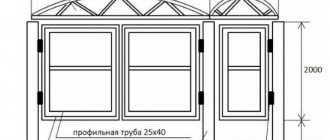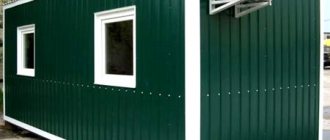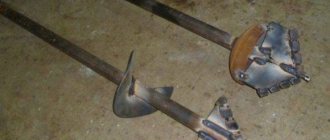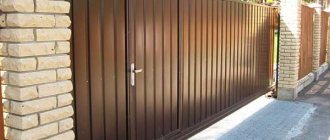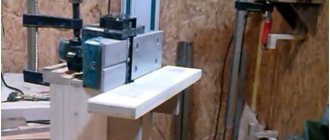When laying ceramic tiles, it is often necessary to cut them to obtain pieces of the desired size. Professional layers use tile cutters for this purpose that cost several thousand rubles. If renovations in an apartment are carried out on your own, it is not profitable to purchase an expensive device for cutting 15-20 tiles. The article will tell you how to make a tile cutter with your own hands from common parts and mechanisms.
Assessing the extent to which it is necessary to manufacture a homemade electric tile cutter
If in order to efficiently perform a small amount of tile laying work there is a need for an electric tool, then after reading the recommendations below, you can make such a tile cutter with your own hands.
Before you start making a homemade electric tile cutter, you should critically evaluate your design and installation abilities and capabilities, since even minor errors in the manufacture of such a device can lead to injury.
If you don’t have confidence in your abilities, then you should at least entrust the assembly of this tool to an experienced performer; ideally, you should rent a factory-made electric tile cutter.
Option 1 - a simple way to make a cutting machine from an angle grinder
A simple way to make a homemade product involves making a base on which fixed connectors for a movable plate are attached. So, in more detail about how to make a machine from an angle grinder:
- Take a steel plate measuring 15x15 cm and at least 2 mm thick. Such a large size is needed in order to secure it to the workbench with bolted connectors. If the workbench (table) is iron, then the base can be welded to it, so in this case you can use a shorter plate 10x10 cm
- Weld two rectangular plates perpendicularly to the base, located at a distance of 5-8 cm from each other. The thickness of the plates should also be at least 2 mm. Their length depends on the size of the power tool, but usually small or medium grinders are used for stationary machines, so the length of the plates is 8-10 cm
- At the base of the plates, make a straight hole into which the connecting bolt is installed. The hole diameter is 6-8 mm, which is not so important
- At the next stage, you will need to make a movable base to which the grinder will be attached. To do this, you will need to take a steel plate at least 20-30 cm long, which depends on the size of the power tool. The width of this frame should be slightly less than the distance between the protrusions of the rectangular plates welded to the base
- On the back side of the movable plate, you need to weld a round oblong sleeve into which the connecting bolt will be placed
- It is necessary to secure the tool to the resulting movable plate using clamps, ties and other methods. The number of fasteners should be more than 2, and preferably at least three for greater safety
- Having secured the resulting structure to the workbench, you can test its operation
For ease of operation, you can weld a handle to the movable bar, and also install an auto-return spring, which will return the tool to its original position, that is, move it up. The photo below shows a ready-made installation for cutting from an angle grinder. As you can see from the example, its manufacture will require a minimum of effort and materials, and the result is a stationary device for cutting various materials.
This is interesting!
Finally, you will need to cut a strip of the appropriate size in the workbench, into which the rotating circle in the tool chuck will “go” when cutting materials.
When constructing the device, do not forget that safe operation depends on how to secure the angle grinder. It should be securely fixed in 2-3 points, which will prevent it from moving during work, as well as “flying off” from the movable frame. When installing the tool on a movable bed, it is necessary that the position of the grinder be strictly at a right angle, that is, the circle must be located strictly in a vertical position.
The resulting device is suitable for processing various materials from wood to durable stone. When working with a tool, do not forget to use safety glasses, gloves, and protective clothing. Instead of a workbench, you can use a wooden or steel frame on which to realize your idea.
This is interesting!
Similar simple frames for grinders are manufactured in the factory, so if you have an extra 2-3 thousand rubles, you can purchase a ready-made base and use it right today. However, there are no difficulties in making it yourself, so you need to decide on your own in each individual case which is better.
Advantages of a tile cutter
| An electric tile cutter is quite an expensive device, and if you are not a professional tiler and are doing simple repairs, then buying it is not justified | If we make a tile cutter with our own hands, then we need to use an appropriate disk. In order to prevent the appearance of dust during tile cutting work, it is necessary to equip the tool with a special container of water. In most cases, it is attached under the disc. During the work period, the disk from the bottom side is dipped into water and washes away dirt and dust. This ensures the most accurate tile cutting work. |
The advantages of an electric tile cutter made from an angle grinder include:
- Possibility of sawing durable porcelain stoneware and stone;
- The fastest possible processing of large volumes of material;
- Ensuring the possibility of the most even cut;
- Reduced wear rate when compared to hand tools.
Due to the presence of a large number of advantages, the grinder is widely used as a tile cutter among many builders. How to make a tile cutter from a grinder can be seen in the video.
Crafts from folk craftsmen
Everyone remembers the saying about the goal, which is cunning in its invention, but our people also love to tinker due to their creative nature. Here are some photos showing the original solutions:
- a simple device made from a piece of plywood and slats. We see an analogue of a tool with a lower engine. His role is played by a fixed Bulgarian woman. The frame is assembled from wooden elements, everything is sheathed on the outside with plywood;
A simple tile cutter made from a piece of plywood and slats
A comment! Honestly, this is a very questionable decision, since you can simply cut with a grinder with exactly the same result. Without guides, chips will not disappear.
- but this solution looks much more impressive. The master managed to use the same grinder to create a real machine with an upper cutting disc;
Grinder machine for cutting tiles
- a stainless steel guide system allows you to move it both back and forth and down and up;
- the whole thing is fixed on a frame made of chipboard. You can easily attach any system of stops and clamps to this material;
- The grinder itself is supported on a carriage made of the same chipboard.
An old grinder is perfect for making a tile cutter.
Homemade tile cutter from a grinder
Homemade wet tile cutter
This is where we summarize our material. We considered only three options, but there are essentially the same types of tile cutters. If you are aiming to create something similar, you will find useful information in our article. We hope it was interesting and informative with us!
What tool can you work with?
You can assemble a homemade tile cutter, but this is not always required, because the process of assembling it will take you quite a lot of time and will also require a certain tool. For example, to make a strong frame, you cannot do without a welding machine, which already imposes certain difficulties.
When working with ceramic tiles, you need to understand that cutting them cannot be avoided
Therefore, to begin with, we will tell you what you can work with when laying tiles without having expensive equipment, and what you still cannot do without.
- One of the simplest devices is a classic glass cutter . It only works with thin ceramic wall tiles. Alternatively, you can use it, but there is a more interesting and convenient solution for the same money.
Glass cutter can be used to cut tiles
Types of manual glass cutters
Glass cutter for cutting tiles- This metal pencil or pobedit scriber perfectly cuts through the glazed surface of ceramic tiles. In addition to it, you need a good metal guide (ruler) and a device for breaking tiles.
Metal scriber with pobedit tip - Tile breaking tongs included in the kit with previous tools. They easily and conveniently split the tiles along the line made.
Tile breaking tongs
Scheme for cutting tiles using a glass cutter, a match and tongs
Even if you can put together a homemade tile cutter, laying tiles is almost impossible without an electric abrasive cutter.
- Firstly, when passing through window and door openings at the corners, it is necessary to make L-shaped cuts.
- Secondly, today in bathrooms they install sockets, hoods and other equipment, for which holes need to be made in the tiles. You can do them with a grinder or use an electric drill with crown attachments for ceramics.
- Thirdly, today porcelain tiles are mostly laid on the floor, and cutting it with a manual tile cutter, even a professional one, is very difficult.
When laying tiles, you can’t do without an electric abrasive cutting machine.
Varieties of facing material and features of its various types
The cutting method depends on the type of facing material. The most important thing in this matter is not only the material, but also the role that is assigned to each tile in the composition. Tiles are usually produced in collections - these are sets that are thought out in terms of color and pattern. Most collections consist of several required elements.
- Background tiles usually do not have designs. Collections may contain several tiles of different colors. It is better to cut tiles in places where the background is uniform, so the cut tiles will not be so noticeable.
- Borders are small elements that separate large color arrays of tiles, often they have a rectangular format. If possible, cutting curbs can be avoided if these elements do not fit the walls.
- Decorated tiles are a type of tile with a pattern or relief image. It is better to immediately avoid cutting tiles with decor. To do this, at the laying stage, the tiles with decor must be taken to the central places of the room. Also, it is not recommended to place tiles with decor under the ceiling or near the floor.
Laying tiles without preliminary layout increases the number of cut elements. If you plan the location on paper, you can avoid a large number of scraps and scraps. Read more about mistakes when laying tiles in the article ""
Floor tiles are usually thicker than wall tiles, making them more difficult to cut. In addition, large-format tiles are more often used on the floor; unevenness when cutting is also noticeable.
Floor tiles have to be cut more often if the corners in the room deviate from 90 degrees. For this reason, to lay tile coverings on the floor, the walls in the room must be level. Read about leveling walls with plaster in the article “”
Tile material
The thickness and strength of the material often depends on the material from which the tile is made. Some materials have a high density, so not every tool is capable of cutting them. Some materials require a delicate approach and can only be cut with specialized tools.
Ceramic tiles are the most common type; they are covered with a decorative glazed coating on top. Ceramic tiles are divided into wall and floor tiles, the latter is usually thicker, which makes it more difficult to cut.
- Porcelain stoneware has a high density, which determines its low water absorption. Because of this, these tiles are often used for floors, wet areas and streets. It will be difficult to cut porcelain stoneware using improvised means; cutting is best done with an electric or manual tile cutter.
- Clinker tiles are a type of high-density cladding; they are used for exterior work (cladding, paving areas, etc.). For thick clinker, you will need a grinder or a water saw (electric tile cutter).
What is needed to make a homemade tool?
An electrical device is much more expensive to manufacture than a mechanical one, but it is more convenient to work with, and the quality of cutting tiles will be much higher. To make it you will need the following:
- table or workbench
- grinder with diamond blade;
- metal platform;
- two steel pipes;
- fasteners;
- clamps.
You can save on equipment if you buy a cheap cutting element, but this is not recommended, since the quality of the cut and productivity of work depend on it.
Choosing an electric motor for a tile cutter
To make a tile cutter with your own hands using an independent electric motor, you need to select and install a gearbox to be able to manually set the required disk rotation speed. Technically, this is not easy to do, so another solution is common - using a small grinder (a grinder for discs with a diameter of 115-125 mm) with the option of manually adjusting the rotation speed.
Electric motor for tile cutter
Practical recommendations
First of all, a metal sheet is attached to the work surface. But before that, you need to cut a slot in it into which the tile cutter disc will fit. The size of the sheet, more precisely, its width, should be chosen so that even the largest tile can fit under the disk. The entire cutting process is controlled by hand, that is, the tile is moved forward along the table under the cutting element itself.
The grinder is attached to the table (in both the first and second cases) using clamps using nuts and locknuts. To ensure that the body of the angle grinder remains undamaged, it is recommended to place the clamps in rubber or PVC tubes. In advance, the clamps are adjusted to the shape of the diameter of the future tile cutter.
Diagram of correct tile cutting.
It should be remembered that when installed vertically, the angle grinder is left without a protective cover, since it cannot be put on, which means that working with such a device is extremely dangerous. Therefore, it is better for the operator to be on the right or left side during the entire process, and in addition use protective equipment - goggles, a respirator and gloves.
If your home workshop will be located in one of the rooms of the apartment, then it is recommended to connect such a tile cutter to a vacuum cleaner. To do this, the socket of the intake hose is fixed under the place where the cutting disc is located. And then during cutting, the grinder and vacuum cleaner turn on simultaneously, which will help get rid of waste materials from the entire process.
A grinder for the base of a tile cutter is quite appropriate, since it uses a minimum of additional components. In addition, thanks to this tool it is possible to achieve the required number of revolutions of the cutting edge in one minute. Otherwise, you will need to look for an additional gearbox that can give an indicator of 4000-5500 rpm.
To make the cut more ideal, a metal corner is installed on the table surface, keeping it parallel to the disk. Thus, by adhering to it, you can achieve high evenness of the cut.
Diagram of the grinder device.
Why do you need a grinder? Using a grinder, an automated tile cutter is made. Hand models, including glass cutters and jigsaws, can form microcracks. This often causes the tiles to crack during tapping. While using a tile cutter based on a grinder helps to avoid such defects.
To protect yourself, you can draw the future cutting line in advance with a pencil. Next, a shallow cut is made along it with a glass cutter, and only then a full cut is made.
Types of homemade tile cutters
Depending on the design features, these devices are divided into 2 types:
- mechanical;
- electric.
The mechanical one is a platform on which the tiles will be fixed and cut. Usually for this purpose they take a thick board with a flat surface. Guides and a cutting element are attached to it, which is usually a glass cutter and replace the cutting head with a blade. You can see a homemade mechanical tool in the figure below:
Hand power saw
A manual electric circular saw made from a grinder is obtained by replacing the standard cutting disc with a wood cutting disc.
True, this option is suitable for short cuts of sheet materials or cutting thin slats. When cutting long lengths or on thick bars, there is a danger of the disc skewing and jamming. It will be much easier to hold the saw if the handle is not positioned perpendicular to the axis of the tool, but is made an extension of the body.
Craftsmen also make a hand-held chain saw from a grinder. True, such a tool is dangerous for the user: the absence of a chain stopper can lead to unpredictable consequences. In addition, the chain is not lubricated, which leads to rapid wear.
We make the tile cutter ourselves
As you already understand, the most popular solution will be a manual tile cutter. It is its design that we have covered in more detail than the others, and it is this that we will try to assemble with our own hands. In this case, the master will make a tile cutter that is capable of cutting 120 cm tiles. You can make a more compact version.
Table. Step-by-step instructions for making a manual tile cutter.
Photos, stepsDescription
| Step 1. Preparing materials | To work, we will need 4 rectangular pipes with a cross section of 50*30 cm, metal plates, steel angles, a pin, bolts, bearings, etc. |
| Step 2. Blanks for the guide | The rail guide will consist of two pipes 130 cm long. We cut them using a grinder, having previously marked the rectangular pipes on four sides with a pencil and a square. Cutting is also done on each side separately to ensure everything is as straight as possible. |
| Step 3. Sanding the rails | We select the side of the pipe with the least rounding and grind it so that nothing interferes, with the same grinder or drill, installing the appropriate attachment. This will be the inner part of the guide in which the carriage will move. Advice! We recommend processing the pipe from all sides at once so that your work is beautiful from an aesthetic point of view. |
| Step 4. Making the bed | For the frame you will also need two pipes, which we cut to the same size and grind. We install a metal strip between them, which will serve as a break, and weld it all together. First, we grab the parts from the ends, after which we turn the element over and go point by point along the entire length. |
| Step 5. Connecting the bed with the slide | The next stage includes several points at once. 1. A stud is welded to the frame at the ends. 2. A slide is made - two pipes are connected so that there is a gap of 4.5 mm between them. 3. Nuts are welded to the guide at the top and bottom, in which the threads are drilled. You can replace them with plates with holes. 4. The structure is assembled in such a way that another, independent one is placed between the nuts, with the help of which the height of the slide will be adjusted. 5. A lock nut is installed to clearly fix the guide in one position. |
| Step 6. Making bushings for bearings | Our carriage will be made of a 4 mm stainless steel sheet, to which a cutting wheel will be attached. The carriage will run due to bearings, the axis of which will be the bolts. The bolts in the bearings are loose, so we make an intermediate sleeve from ordinary nuts, grinding off all the edges with a grinder. For this we use a fixed drill and a bolt clamped in its chuck. Everything is very simple and done quickly. |
| Step 7. Assembling the guide | We first assemble the moving element. It is assembled in the following sequence: bolt; sleeve; bearing; two adapter nuts, between which the carriage will then be clamped; sleeve; bearing; screw. |
| Step 8. All parts for assembling the carriage | The base of the carriage in the photo is on the left. A part is cut out of a piece of stainless steel, to which a nut is welded on top, and holes for moving parts are drilled at the bottom. |
| Step 9. Start assembling the carriage | The cutting wheel on a bearing is mounted between two brackets, after which everything is bolted together. |
| Step 10. Connecting elements into one system | Install the cutting wheel on the carriage. The far mount (large bolt) is the mechanical part that we pre-assembled before. Interesting! Please note that the wheel can be installed in two positions. |
| Step 11. Fixing the separator | We fasten the last structural element – the separator. Let us remind you that we use it to break the tile when pressed. Advice! Photos show detailed assembly for better visibility. You will have to do it right away on the machine itself, otherwise you won’t be able to push the carriage inside. |
| Step 12. Finished tile cutter | Let's add the finishing touches to our design: · attach a handle - in the example, the master used a piece of polypropylene pipe; · glue pieces of foamed heat insulator as a soft base of the frame; · install a clamp on the carriage above the rails so that it does not slip. By the way, bearings could also be placed on top for better sliding. |
The work of making such a tile cutter is not easy and requires the performer to have certain turner skills, but if you have all this, as well as free time, you can make a very high-quality working tool. Such a handsome man has, perhaps, only one drawback - he will be very heavy.
Making a mechanical tile cutter with your own hands
A manual tile cutter is a safe tool and does not require connection to an electrical outlet. These two factors ensure the popularity of this model. In addition, due to its relatively light weight, such a tool is easy to transport and you don’t have to spend a lot of money on its production.
How do you tap walls for wiring?
Like any other construction and repair work, gating can be done manually or mechanized.
For manual work use:
- chisel. A universal tool for working with any hard materials, from wood to stone. Used in conjunction with a hammer. For mechanized chipping, hammer drill chisels are used;
- scarpel (feminine) or a hammer, a tool similar to a chisel and chisel for working with hard stone, concrete, brick, and so on. There is also a manual version and for power tools.
Since manual gating is convenient only in small areas and not too hard materials - otherwise the task becomes unnecessarily labor-intensive - universal and specialized power tools are most often used:
- a hammer drill with a chisel or scarpel installed in it. Depending on the material of the building structure, the selected type of nozzle (including the width and material of the working part) and the impact power of the hammer drill, furrows of a larger or smaller cross-section can be made. However, they always turn out uneven, with broken edges. It is also possible that fragments of masonry/monolith/plaster may fall out during the process;
- drill. Here the work is carried out in several stages - first, holes are drilled (in the normal operating mode of the tool) to the groove depth in increments of 1.5...2 mm. It is advisable to choose a drill with a diameter close to the required groove width. Next, using a spatula, “select” the material between the holes. The disadvantage of this method is the same as that of a puncher, a sloppy appearance and uneven edges of the furrow. In addition, changing the operating mode (lateral loads instead of axial loads when working with a blade) can lead to rapid tool failure;
- grinder or angle grinder. In both cases, special discs are used for work, designed for working on concrete (brick, aerated concrete, and so on). They cut the edges of the groove at the desired distance, after which the material between the cut grooves is removed using any other hand or power tool. In this case, even when working with a hammer drill, the edges are quite smooth;
- wall chaser This is a professional and quite expensive tool, rarely used by home craftsmen, but it is the one that allows you to perform gating as efficiently and quickly as possible. Almost always this device is equipped with an output to an industrial vacuum cleaner.
Additional upgrade
The tool can be supplemented with a dust collector. To do this, a groove about 4 cm wide and 1 cm deep is made from the bottom side of the textolite base. It starts next to the edge of the cutting wheel and ends on the opposite side of the base, a few centimeters before the edge. A hole with a diameter of 3–4 cm is drilled in this place. A metal plate with a hole is attached to it using screws on top, to which an adapter 4–5 cm long, cut from a metal pipe, is welded. The diameter of the pipe is equal to the internal diameter of the vacuum cleaner air duct, which is put on the adapter. Now, when you turn on the vacuum cleaner, all dust will be sucked out from the work area.
You can make a simple guide device for a tile cutter, thanks to which the accuracy and quality of the resulting cut will increase significantly. For this, a metal plaster rule of the required length is used. It is secured to the tile using clamps (double-sided construction tape will also work) at the required distance to the cutting line. Resting against the smooth edge of the rule, the tile cutter moves along it and makes a perfectly straight cut.
Making a tile cutting table
In order for the ceramics to flow smoothly under the disc, you need to make a smooth tabletop. In addition, it must be strong enough to securely secure the cutting tool. Therefore, experts advise using a rigid steel frame made of corners to make the tabletop. All parts must be connected by electric welding. Then we adjust the tabletop to the finished frame. A sheet of steel 0.5-0.6 cm high is suitable for this. Make a slot on it for the saw blade with an excess of 0.2-0.3 cm.
Note! To protect yourself when working, mount the angle grinder so that its disk does not protrude more than halfway from the slot.
Under the tabletop, in continuation of the gap or parallel to it, you need to weld a steel profile measuring 0.4 * 0.6 cm or a steel strip 0.4-0.5 cm thick. A grinder will be attached to them later.
On the fixture table, install the moving bar parallel to the grinder to directly feed the tiles under the disc. To do this, to the left of the grinder, perpendicular to it, make 2 parallel slits at a distance of the length of the bar between each other. HP will move along them. Its ends will be secured with bolt nuts through the slot.
Installing an angle grinder
You can attach the grinder to the bottom of the tabletop in different ways. Make sure that the fastening is rigid and strong. This is important because otherwise, when cutting tiles, the grinder may jam in the slots of the countertop. Also, when installing the saw, consider the possibility of:
- operate the on/off buttons;
- adjust the grinder rotation speed;
- change disk.
To prevent the bolt from turning out, a Grover spring washer is placed under its head.
Grover's washer
Also, to this connection, the tile cutter is attached to the tabletop with clamps made of strip steel, made according to the table drawing. To lay between the “body” of the file and the table, wooden blocks are used. Grooves should be made in them according to the shape of the grinder.
How to cool a homemade tile cutter
Factory electric tile cutters have a water cooling system. Its design is influenced by the location of the grinder, that is, it can be above or below the table. Making an electric water-cooled tile cutter of this type at home is extremely difficult and pointless. To cool a diamond blade, a simple air blow is enough.
It is also important to remember that you cannot use an angle grinder if the humidity level is more than 85 percent. Based on this, it can be assumed that the file cannot be wetted.
Do-it-yourself wall chaser from a grinder
Let's look at how to make a device for cutting walls for wiring (or other work), using a grinder as a base.
This homemade product will be useful for those who independently make repairs in an apartment or house (in particular, carry out work on installing electrical wiring) and want to save money.
For example, for one-time work there is no point in purchasing an expensive factory tool, which will then lie idle.
To make a homemade wall chaser from a grinder
, the author will use a welding machine and a lathe.
What you will need
Of the basic materials for making homemade products, we will need:
- thick steel washers (you can buy or turn them on a lathe with your own hands);
- extended couplings;
- long bolt (it is advisable to choose one with a high strength class);
- housing bearing;
- sheet metal;
- discs
designed for working with concrete and stone.
Now let's start making a nozzle for the grinder for gating
Stages of work
The first step is to make three washers - using a crown, we cut out three blanks from a sheet of metal. Then the author turns them on a lathe.
Next we need two extended couplings. One of them needs to be shortened. Then the master processes the couplings on a lathe - on one side of each coupling it is necessary to machine a seat for the washer.
After this, in two prepared metal washers, using a step drill, we drill out the central hole to the desired diameter. We put washers on the elongated couplings and scald them.
We clean the weld seams with a grinder. We prepare two ordinary washers, a long bolt and a housing bearing.
All prepared parts will need to be assembled in the following order:
- We put a regular metal washer on the long bolt.
- Then install the housing bearing.
- We put on another washer (regular).
- We put a thick washer on the bolt with a groove for the disc (which we made earlier).
- We install the saw blade on concrete.
- We screw a cut-off elongated coupling with a welded washer onto the bolt.
- We screw on the second extended coupling with a washer.
- concrete
saw blade on the grinder . - After this, we screw the assembled structure onto the gearbox shaft of the angle
.
Making a protective casing
We cut out three parts from sheet metal about 3-4 mm thick: the side walls and the upper part of the protective casing.
We make a fastening clamp. Then we weld it to one of the side walls.
We weld the entire protective casing for the wall chaser - there should be enough space inside to install two disks
. It will additionally be necessary to weld a mount to it to install the handle.
At the last stage, all that remains is to assemble all the parts together: attach the protective casing to the angle grinder
, install the first disk, then install the shaft with the housing bearing, couplings and disk. Everything needs to be secured well.
Details on how to make a homemade wall chaser attachment for an angle grinder
, you can watch the video below. This idea was shared by YouTube channel creator Sean Beardon.
Recommendations for gating
Before ditching the wall, you will need to make a marking and cut along it - this is much more convenient, and the result will be of better quality.
Please note: it is best to cut a wall groove from top to bottom. The depth of the groove for one cable is at least 15 mm
If several cables will be laid in one groove, the depth of the groove must be increased. The main condition is that the cables fit freely into the groove and do not stick out of it
The depth of the groove for one cable is at least 15 mm. If several cables will be laid in one groove, the depth of the groove must be increased. The main condition is that the cables fit freely into the groove and do not stick out of it.
The width of the groove must be such that a hammer blade or chisel can fit into it.
When chipping walls, a lot of dust
, therefore it is advisable to provide the possibility of its removal. vacuum cleaner is used for this.
, the hose of which is connected to a pipe attached to the protective casing.
Tips for using the tool
A tile cutter from an angle grinder is an easy-to-use tool, but, as with any electrical equipment, the following safety rules should be followed when working with it.
- It is necessary to cut the tiles away from you, without creating too much pressure.
- It is recommended to start cutting from the outside of the tile.
- If you need to cut tiles, it is better to fix them with special pliers. This will allow you to do the job better.
- It is strictly forbidden to operate the tool while intoxicated or after taking antihistamines, as this may cause injury.
- If you have never worked with such equipment before, then before you start cutting tiles, it is recommended to practice a little so as not to inadvertently spoil it.
- In order for the cutting line to be perfectly straight, you need to draw a straight line on the tile with a simple pencil.
- When cutting tiles, you must wear safety glasses to prevent dust or small chips from getting into your eyes.
If you live with small children, then you need to store electric tools in a room to which they do not have access.
Bottom line
A tile cutter is a very necessary thing for arranging home comfort. If you doubt that you can do it yourself, it is better to rent the device or use the services of a specialist.
Sources
- https://DoctorPol.ru/nap-pokrytiya/plitochka/stanok-rezki-dlya-plitki.html
- https://tehnika.expert/dlya-remonta/bolgarka/kak-sdelat-plitkorez-svoimi-rukami.html
- https://yaplitka.ru/plitkorez-svoimi-rukami.html
- https://kitchenremont.ru/remont/plitkorez-svoimi-rukami
- https://laminatepol.ru/28443-plitkoreza-svoimi-rukami.html
- https://IzPlitki.com/instrumenty/camodelnyj-plitkorez.html
- https://TehnoPanorama.ru/instrumenty/plitkorez-svoimi-rukami.html
Post Views: 233




